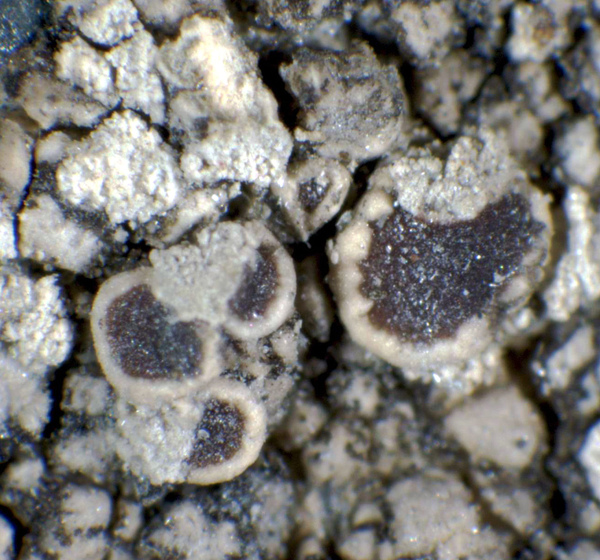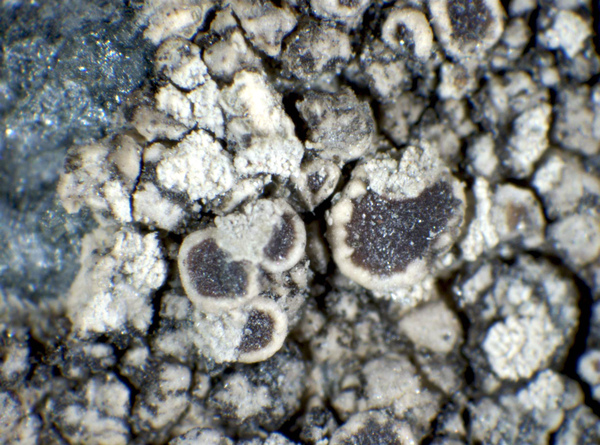Lecanora umbrosa Degel.
Bot. Not.: 105, 1943.
Synonyms: Ionaspis epulotica var. macrocarpa Creveld; Lecanora neglecta (Räsänen) Räsänen; Lecanora sorediifera (Th. Fr.) Räsänen non Fée; Lecanora subfusca var. sorediifera Th. Fr.
Description: Thallus crustose, episubstratic, continuous or areolate-verruculose, whitish to yellowish grey, sorediate, sometimes delimited by a thin white prothallus, the soredia 25-50 µm in diam., arranged in confluent, white to yellowish white, flat to concave, 0.3-0.7(-1) mm wide soralia. Apothecia rather rare, lecanorine, sessile, (0.5-)1-2(-3) mm across, with a red-brown, mostly flat, epruinose disc and a persistent, entire or flexuose, smooth or partially sorediate thalline margin. Thalline exciple more or less distinctly corticate, with numerous algal cells, the medulla with small crystals partly soluble in K; proper exciple colourless, with crystals insoluble in K; epithecium red-brown to orange-brown, the pigment not dissolving in K, without crystals; hymenium colourless, 60-90 µm high, not inspersed with oil droplets; paraphyses slightly or not thickened at apex; hypothecium colourless, not inspersed. Asci 8-spored, clavate, very thin-walled, with a K/I+ blue, tall tholus penetrated by a faintly amyloid apical cushion, the wall K/I-, surrounded by a blue outer layer, Lecanora-type. Ascospores 1-celled, hyaline, broadly ellipsoid, (9-)11-15(-17) x 6-9(-12) µm, the wall < 1 µm thick. Spot tests: K+ yellow, C-, KC-, P- or P+ pale yellow. Chemistry: atranorin (major), chloroatranorin (minor), and unidentified triterpenoids.
Growth form: Crustose
Substrata: rocks
Photobiont: green algae other than Trentepohlia
Reproductive strategy: mainly asexual, by soredia, or soredia-like structures (e.g. blastidia)
Commonnes-rarity: (info)
Alpine belt: very rare
Subalpine belt: rather rare
Montane belt: extremely rare
Dry submediterranean belt: absent
Humid submediterranean belt: absent
Padanian area: absent
pH of the substrata:
1 2 3 4 5
Solar irradiation:
1 2 3 4 5
Aridity:
1 2 3 4 5
Eutrophication:
1 2 3 4 5
Poleotolerance:
0 1 2 3
Altitudinal distribution:
1 2 3 4 5 6
Rarity
absent
extremely rare
very rare
rare
rather rare
rather common
common
very common
extremely common
Loading data...
Occurrence data
Predictive map
Growth form: Crustose
Substrata: rocks
Photobiont: green algae other than Trentepohlia
Reproductive strategy: mainly asexual, by soredia, or soredia-like structures (e.g. blastidia)
Commonnes-rarity: (info)
Alpine belt: very rare
Subalpine belt: rather rare
Montane belt: extremely rare
Dry submediterranean belt: absent
Humid submediterranean belt: absent
Padanian area: absent
pH of the substrata:
| 1 | 2 | 3 | 4 | 5 |
Solar irradiation:
| 1 | 2 | 3 | 4 | 5 |
Aridity:
| 1 | 2 | 3 | 4 | 5 |
Eutrophication:
| 1 | 2 | 3 | 4 | 5 |
Poleotolerance:
| 0 | 1 | 2 | 3 |
Altitudinal distribution:
| 1 | 2 | 3 | 4 | 5 | 6 |
Rarity
absent
extremely rare
very rare
rare
rather rare
rather common
common
very common
extremely common
Loading data...
Occurrence data
Predictive map








